Dublin Business School - Machine Learning Assignment: CA2 Analysis
VerifiedAdded on 2022/08/18
|5
|1180
|13
Homework Assignment
AI Summary
This assignment solution provides a comprehensive overview of machine learning concepts and techniques. It begins with definitions of AI, machine learning, and deep learning, followed by explanations of parametric and non-parametric models. The solution delves into supervised and unsupervised learning, detailing their components and providing examples. The assignment also addresses common types of errors in machine learning and explores the advantages and disadvantages of applying machine learning in research projects. The solution also includes discussion on overfitting, underfitting, and model selection. The document also discusses the advantages and disadvantages of using machine learning in research projects. The solution is supported by references to relevant academic sources.
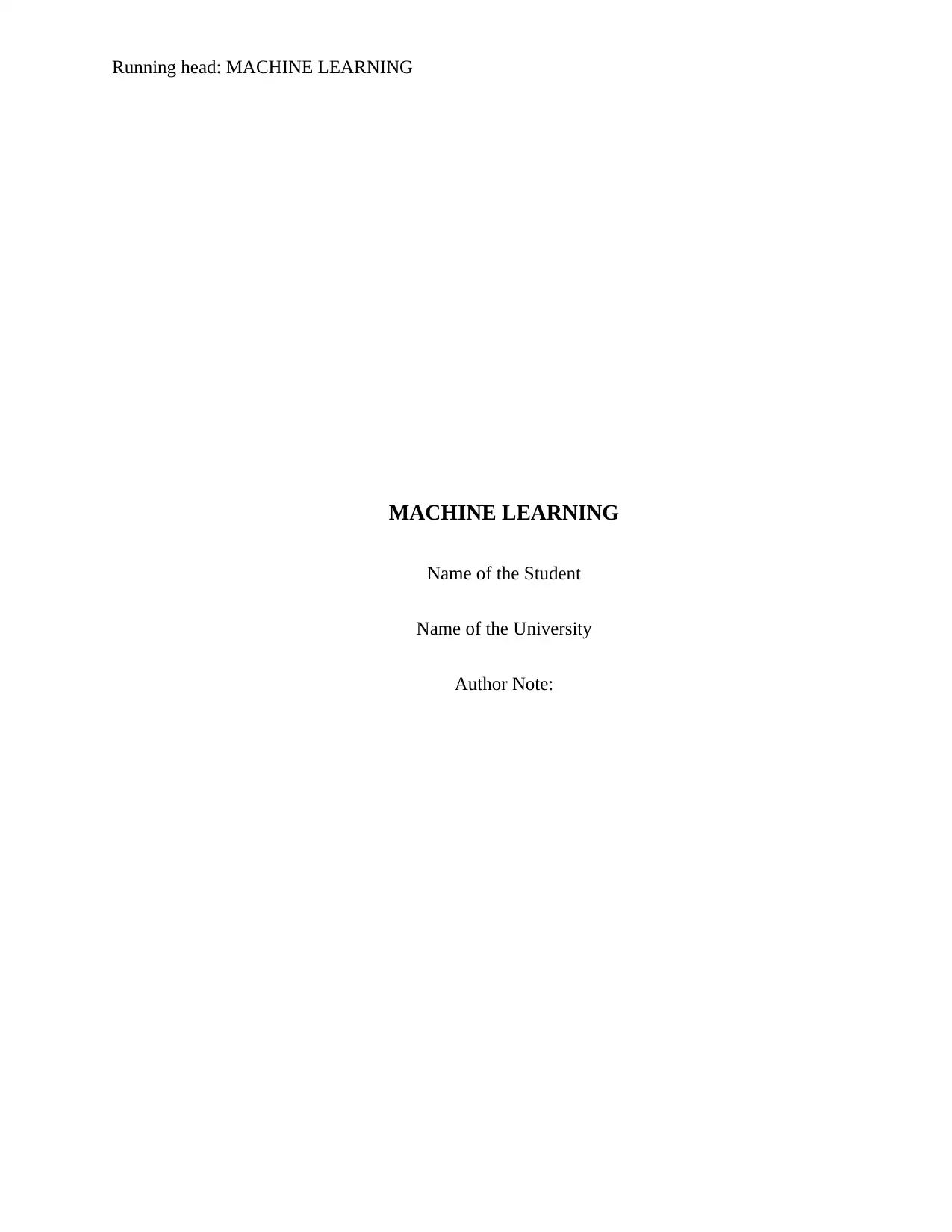
Running head: MACHINE LEARNING
MACHINE LEARNING
Name of the Student
Name of the University
Author Note:
MACHINE LEARNING
Name of the Student
Name of the University
Author Note:
Paraphrase This Document
Need a fresh take? Get an instant paraphrase of this document with our AI Paraphraser
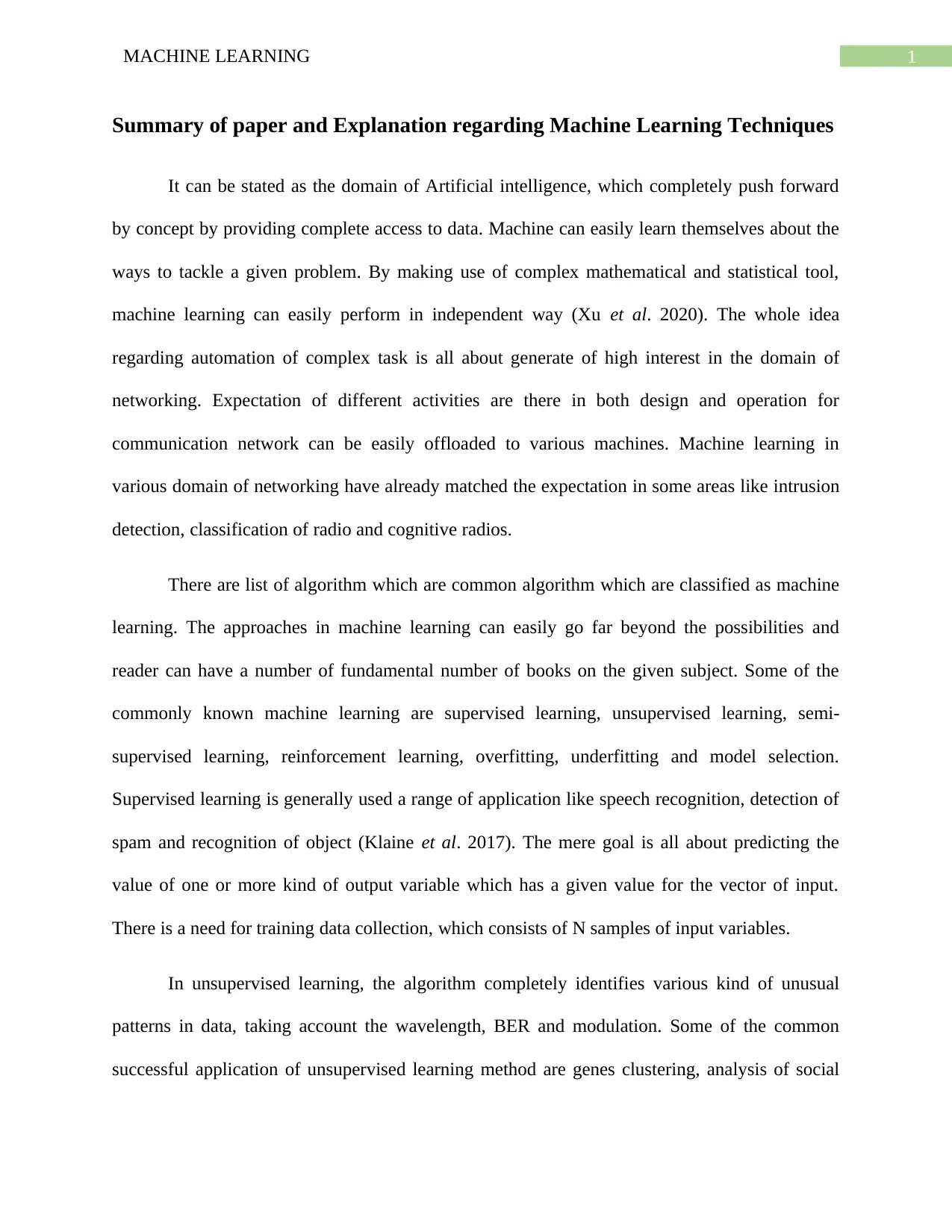
1MACHINE LEARNING
Summary of paper and Explanation regarding Machine Learning Techniques
It can be stated as the domain of Artificial intelligence, which completely push forward
by concept by providing complete access to data. Machine can easily learn themselves about the
ways to tackle a given problem. By making use of complex mathematical and statistical tool,
machine learning can easily perform in independent way (Xu et al. 2020). The whole idea
regarding automation of complex task is all about generate of high interest in the domain of
networking. Expectation of different activities are there in both design and operation for
communication network can be easily offloaded to various machines. Machine learning in
various domain of networking have already matched the expectation in some areas like intrusion
detection, classification of radio and cognitive radios.
There are list of algorithm which are common algorithm which are classified as machine
learning. The approaches in machine learning can easily go far beyond the possibilities and
reader can have a number of fundamental number of books on the given subject. Some of the
commonly known machine learning are supervised learning, unsupervised learning, semi-
supervised learning, reinforcement learning, overfitting, underfitting and model selection.
Supervised learning is generally used a range of application like speech recognition, detection of
spam and recognition of object (Klaine et al. 2017). The mere goal is all about predicting the
value of one or more kind of output variable which has a given value for the vector of input.
There is a need for training data collection, which consists of N samples of input variables.
In unsupervised learning, the algorithm completely identifies various kind of unusual
patterns in data, taking account the wavelength, BER and modulation. Some of the common
successful application of unsupervised learning method are genes clustering, analysis of social
Summary of paper and Explanation regarding Machine Learning Techniques
It can be stated as the domain of Artificial intelligence, which completely push forward
by concept by providing complete access to data. Machine can easily learn themselves about the
ways to tackle a given problem. By making use of complex mathematical and statistical tool,
machine learning can easily perform in independent way (Xu et al. 2020). The whole idea
regarding automation of complex task is all about generate of high interest in the domain of
networking. Expectation of different activities are there in both design and operation for
communication network can be easily offloaded to various machines. Machine learning in
various domain of networking have already matched the expectation in some areas like intrusion
detection, classification of radio and cognitive radios.
There are list of algorithm which are common algorithm which are classified as machine
learning. The approaches in machine learning can easily go far beyond the possibilities and
reader can have a number of fundamental number of books on the given subject. Some of the
commonly known machine learning are supervised learning, unsupervised learning, semi-
supervised learning, reinforcement learning, overfitting, underfitting and model selection.
Supervised learning is generally used a range of application like speech recognition, detection of
spam and recognition of object (Klaine et al. 2017). The mere goal is all about predicting the
value of one or more kind of output variable which has a given value for the vector of input.
There is a need for training data collection, which consists of N samples of input variables.
In unsupervised learning, the algorithm completely identifies various kind of unusual
patterns in data, taking account the wavelength, BER and modulation. Some of the common
successful application of unsupervised learning method are genes clustering, analysis of social
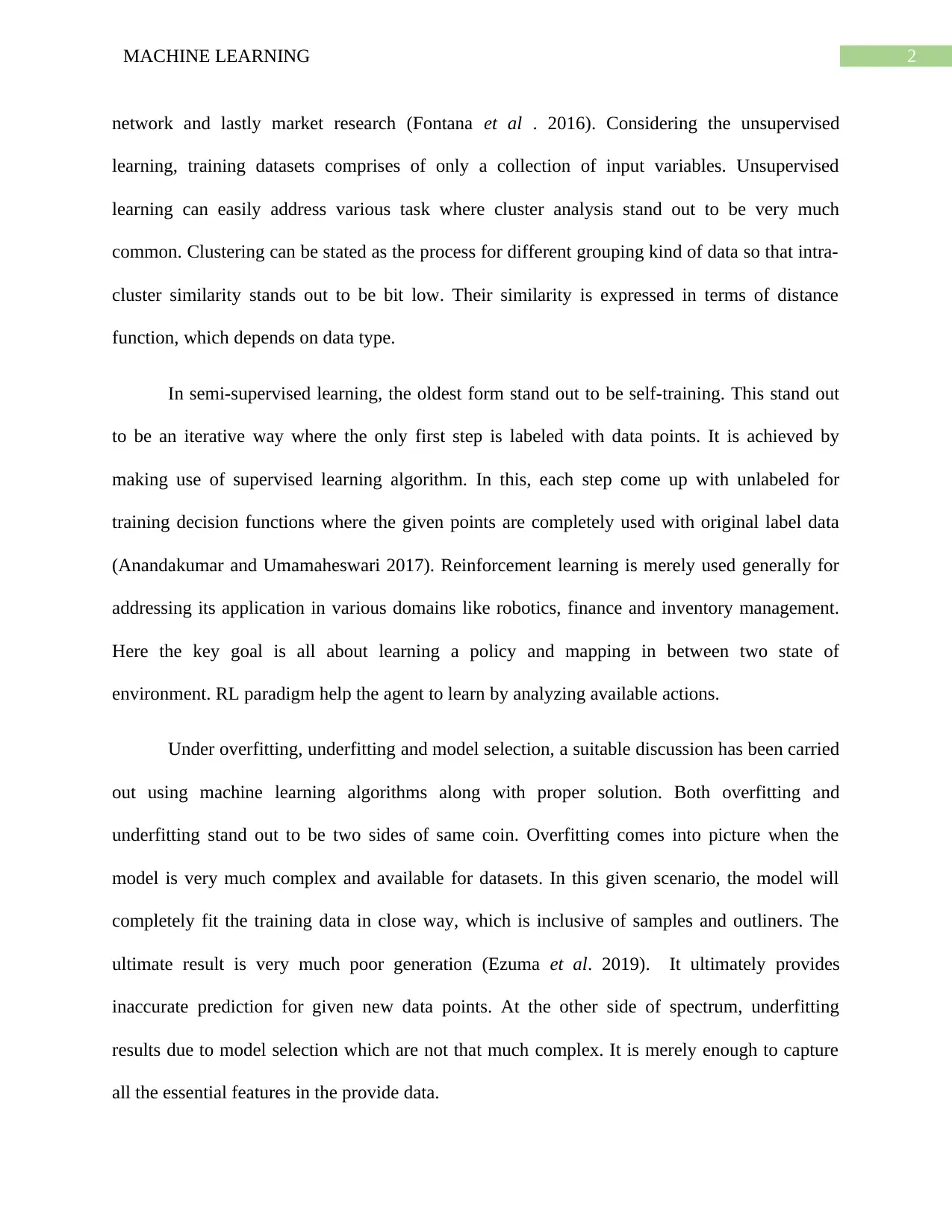
2MACHINE LEARNING
network and lastly market research (Fontana et al . 2016). Considering the unsupervised
learning, training datasets comprises of only a collection of input variables. Unsupervised
learning can easily address various task where cluster analysis stand out to be very much
common. Clustering can be stated as the process for different grouping kind of data so that intra-
cluster similarity stands out to be bit low. Their similarity is expressed in terms of distance
function, which depends on data type.
In semi-supervised learning, the oldest form stand out to be self-training. This stand out
to be an iterative way where the only first step is labeled with data points. It is achieved by
making use of supervised learning algorithm. In this, each step come up with unlabeled for
training decision functions where the given points are completely used with original label data
(Anandakumar and Umamaheswari 2017). Reinforcement learning is merely used generally for
addressing its application in various domains like robotics, finance and inventory management.
Here the key goal is all about learning a policy and mapping in between two state of
environment. RL paradigm help the agent to learn by analyzing available actions.
Under overfitting, underfitting and model selection, a suitable discussion has been carried
out using machine learning algorithms along with proper solution. Both overfitting and
underfitting stand out to be two sides of same coin. Overfitting comes into picture when the
model is very much complex and available for datasets. In this given scenario, the model will
completely fit the training data in close way, which is inclusive of samples and outliners. The
ultimate result is very much poor generation (Ezuma et al. 2019). It ultimately provides
inaccurate prediction for given new data points. At the other side of spectrum, underfitting
results due to model selection which are not that much complex. It is merely enough to capture
all the essential features in the provide data.
network and lastly market research (Fontana et al . 2016). Considering the unsupervised
learning, training datasets comprises of only a collection of input variables. Unsupervised
learning can easily address various task where cluster analysis stand out to be very much
common. Clustering can be stated as the process for different grouping kind of data so that intra-
cluster similarity stands out to be bit low. Their similarity is expressed in terms of distance
function, which depends on data type.
In semi-supervised learning, the oldest form stand out to be self-training. This stand out
to be an iterative way where the only first step is labeled with data points. It is achieved by
making use of supervised learning algorithm. In this, each step come up with unlabeled for
training decision functions where the given points are completely used with original label data
(Anandakumar and Umamaheswari 2017). Reinforcement learning is merely used generally for
addressing its application in various domains like robotics, finance and inventory management.
Here the key goal is all about learning a policy and mapping in between two state of
environment. RL paradigm help the agent to learn by analyzing available actions.
Under overfitting, underfitting and model selection, a suitable discussion has been carried
out using machine learning algorithms along with proper solution. Both overfitting and
underfitting stand out to be two sides of same coin. Overfitting comes into picture when the
model is very much complex and available for datasets. In this given scenario, the model will
completely fit the training data in close way, which is inclusive of samples and outliners. The
ultimate result is very much poor generation (Ezuma et al. 2019). It ultimately provides
inaccurate prediction for given new data points. At the other side of spectrum, underfitting
results due to model selection which are not that much complex. It is merely enough to capture
all the essential features in the provide data.
⊘ This is a preview!⊘
Do you want full access?
Subscribe today to unlock all pages.

Trusted by 1+ million students worldwide
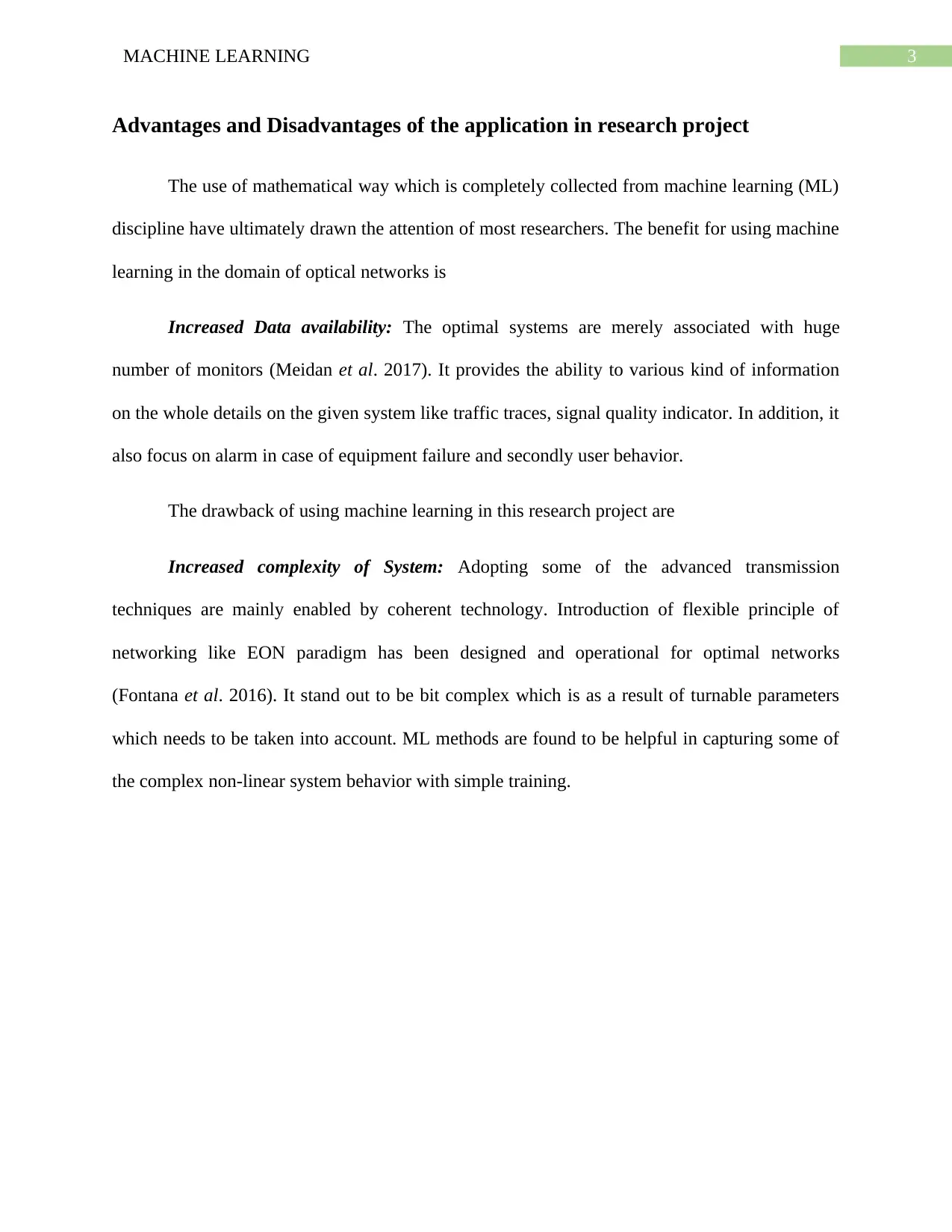
3MACHINE LEARNING
Advantages and Disadvantages of the application in research project
The use of mathematical way which is completely collected from machine learning (ML)
discipline have ultimately drawn the attention of most researchers. The benefit for using machine
learning in the domain of optical networks is
Increased Data availability: The optimal systems are merely associated with huge
number of monitors (Meidan et al. 2017). It provides the ability to various kind of information
on the whole details on the given system like traffic traces, signal quality indicator. In addition, it
also focus on alarm in case of equipment failure and secondly user behavior.
The drawback of using machine learning in this research project are
Increased complexity of System: Adopting some of the advanced transmission
techniques are mainly enabled by coherent technology. Introduction of flexible principle of
networking like EON paradigm has been designed and operational for optimal networks
(Fontana et al. 2016). It stand out to be bit complex which is as a result of turnable parameters
which needs to be taken into account. ML methods are found to be helpful in capturing some of
the complex non-linear system behavior with simple training.
Advantages and Disadvantages of the application in research project
The use of mathematical way which is completely collected from machine learning (ML)
discipline have ultimately drawn the attention of most researchers. The benefit for using machine
learning in the domain of optical networks is
Increased Data availability: The optimal systems are merely associated with huge
number of monitors (Meidan et al. 2017). It provides the ability to various kind of information
on the whole details on the given system like traffic traces, signal quality indicator. In addition, it
also focus on alarm in case of equipment failure and secondly user behavior.
The drawback of using machine learning in this research project are
Increased complexity of System: Adopting some of the advanced transmission
techniques are mainly enabled by coherent technology. Introduction of flexible principle of
networking like EON paradigm has been designed and operational for optimal networks
(Fontana et al. 2016). It stand out to be bit complex which is as a result of turnable parameters
which needs to be taken into account. ML methods are found to be helpful in capturing some of
the complex non-linear system behavior with simple training.
Paraphrase This Document
Need a fresh take? Get an instant paraphrase of this document with our AI Paraphraser
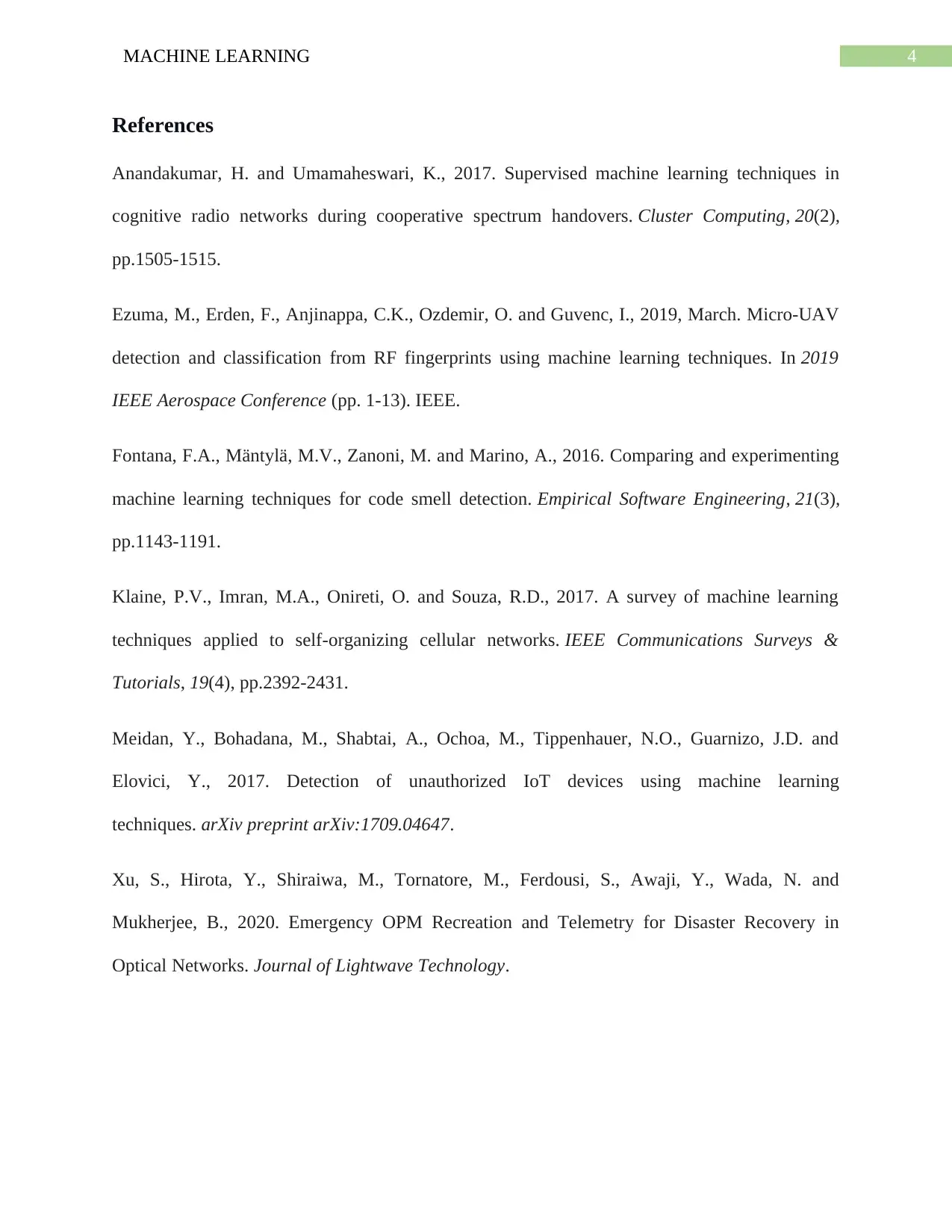
4MACHINE LEARNING
References
Anandakumar, H. and Umamaheswari, K., 2017. Supervised machine learning techniques in
cognitive radio networks during cooperative spectrum handovers. Cluster Computing, 20(2),
pp.1505-1515.
Ezuma, M., Erden, F., Anjinappa, C.K., Ozdemir, O. and Guvenc, I., 2019, March. Micro-UAV
detection and classification from RF fingerprints using machine learning techniques. In 2019
IEEE Aerospace Conference (pp. 1-13). IEEE.
Fontana, F.A., Mäntylä, M.V., Zanoni, M. and Marino, A., 2016. Comparing and experimenting
machine learning techniques for code smell detection. Empirical Software Engineering, 21(3),
pp.1143-1191.
Klaine, P.V., Imran, M.A., Onireti, O. and Souza, R.D., 2017. A survey of machine learning
techniques applied to self-organizing cellular networks. IEEE Communications Surveys &
Tutorials, 19(4), pp.2392-2431.
Meidan, Y., Bohadana, M., Shabtai, A., Ochoa, M., Tippenhauer, N.O., Guarnizo, J.D. and
Elovici, Y., 2017. Detection of unauthorized IoT devices using machine learning
techniques. arXiv preprint arXiv:1709.04647.
Xu, S., Hirota, Y., Shiraiwa, M., Tornatore, M., Ferdousi, S., Awaji, Y., Wada, N. and
Mukherjee, B., 2020. Emergency OPM Recreation and Telemetry for Disaster Recovery in
Optical Networks. Journal of Lightwave Technology.
References
Anandakumar, H. and Umamaheswari, K., 2017. Supervised machine learning techniques in
cognitive radio networks during cooperative spectrum handovers. Cluster Computing, 20(2),
pp.1505-1515.
Ezuma, M., Erden, F., Anjinappa, C.K., Ozdemir, O. and Guvenc, I., 2019, March. Micro-UAV
detection and classification from RF fingerprints using machine learning techniques. In 2019
IEEE Aerospace Conference (pp. 1-13). IEEE.
Fontana, F.A., Mäntylä, M.V., Zanoni, M. and Marino, A., 2016. Comparing and experimenting
machine learning techniques for code smell detection. Empirical Software Engineering, 21(3),
pp.1143-1191.
Klaine, P.V., Imran, M.A., Onireti, O. and Souza, R.D., 2017. A survey of machine learning
techniques applied to self-organizing cellular networks. IEEE Communications Surveys &
Tutorials, 19(4), pp.2392-2431.
Meidan, Y., Bohadana, M., Shabtai, A., Ochoa, M., Tippenhauer, N.O., Guarnizo, J.D. and
Elovici, Y., 2017. Detection of unauthorized IoT devices using machine learning
techniques. arXiv preprint arXiv:1709.04647.
Xu, S., Hirota, Y., Shiraiwa, M., Tornatore, M., Ferdousi, S., Awaji, Y., Wada, N. and
Mukherjee, B., 2020. Emergency OPM Recreation and Telemetry for Disaster Recovery in
Optical Networks. Journal of Lightwave Technology.
1 out of 5
Related Documents
Your All-in-One AI-Powered Toolkit for Academic Success.
+13062052269
info@desklib.com
Available 24*7 on WhatsApp / Email
![[object Object]](/_next/static/media/star-bottom.7253800d.svg)
Unlock your academic potential
Copyright © 2020–2025 A2Z Services. All Rights Reserved. Developed and managed by ZUCOL.





